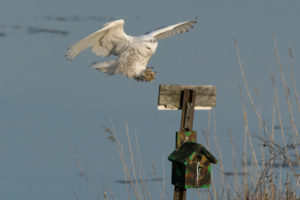What do owls, invasive species, impervious surfaces, conservation legislation and drinking water have in common? They are all of special interest to us here at HRWC. Read on to learn what is News to Us this month.

There is still a chance to spot our winter neighbor — the snowy owl. These owls are a special treat in our area, spending time in the Huron over the winter before returning to the Arctic where they spend the rest of the year. Hobbyists can help researchers track birds by submitting sightings.
Invasive species control requires more than talk HRWC has undertaken an effort to produce kits, trainings and information to limit the spread of aquatic invasive species. This article discusses multiple approaches to invasive species control, asserting that we need more than outreach and voluntary adoption of good practices>. Boat inspection stations are another useful tool along with regulation and enforcement. Learn more about HRWC invasive species control efforts here.
Which Countries Have the Most Pavement Per Person? Here is an interesting look at pavement around the globe. The analysis ranks countries by impervious surface per capita and as you might guess, the United States is among the worst. This article also discusses the implications of so much pavement for health and the environment.
PFAS, dioxane top concerns at clean water forum in Scio Township HRWC participated in a public forum organized by State Representative Donna Lasinski in Scio Township to provide an update on PFAS and 1,4 Dioxane contaminating surface and ground water in the Huron. Washtenaw County Environmental Health and City of Ann Arbor also addressed health and drinking water concerns.
Congress passes conservation bill honoring John Dingell Just a month after the death of Representative John Dingell, a sweeping piece of bi-partisan conservation legislation bearing his name has passed through Congress. The John D. Dingell Jr. Conservation, Management and Recreation Act expands land area and protections for public lands throughout the United States. It includes a permanent authorization of the Land and Water Conservation Fund (LWCF) which has been the source of funding for many of Michigan’s protected lands and waters. On March 11, President Trump signed this bill into law



